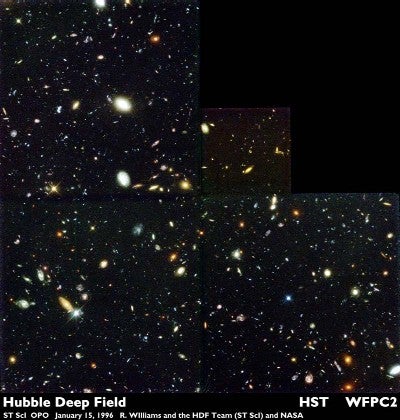Approaching the edge of space and time
Hubble’s latest image provides a view of the early universe, when the first galaxies were coming together
Robert Naeye
The image captures 1,500 to 2,000 galaxies at various stages of evolution. We see the faintest galaxies, unassuming red smudges, as they existed less than 1 billion years after the big bang. “The variety of galaxies we see in the early universe is amazing. There are large ones and small ones, red ones and blue ones, very structured ones and also amorphous ones, says Robert Williams, director of the Space Telescope Science Institute in Baltimore, Maryland. “We are clearly seeing some of these galaxies as they were more than 10 billion years ago, in the process of formation. As the images have come up on our screens, we have not been able to keep from wondering if we might somehow be seeing our own origins in all of this. This has been an unbelievable experience.
The dimmest objects are nearly 30th magnitude, which is how bright the glow of a cigar would appear from the Moon. To capture objects this faint, Hubble had to stare at a tiny spot in space for 10 consecutive days, over 150 Earth orbits. These 10 straight days of observing time were broken into 342 exposures, lasting 15 to 40 minutes each. Separate images were taken in ultraviolet, blue, red, and infrared light and then combined into a single color picture. Astronomers can infer the galaxies’ distances, ages, and compositions based on their color.
Hubble beamed this image to scientists the past December, so scientific analysis has just begun. Astronomers expect the photo to help answer questions about how soon after the big bang galaxies evolved over the lifetime of the universe.
The image will answer questions about the universe’s destiny as well as its past. By carefully measuring the sizes and brightnesses of the distant galaxies, and comparing them to nearby galaxies, astronomers will be able to determine how much spacetime is curved. This in turn will tell them whether the universe is destined to expand forever, or whether it will collapse back upon itself in a fiery death some unimaginable time in the future.










